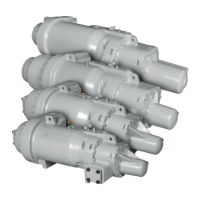20
Certain fully unloaded operating conditions may result in
discharge gas temperatures which exceed the
recommended operating parameters. Carlyle requires
that some form of liquid injection be applied to control/
reduce discharge gas temperatures to be within recom-
mended guidelines. Common methods to accomplish this
may include increased flow through the economizer cir-
cuit or direct liquid inject
ion into the economizer port/tub-
ing. Please refer to Refrigeration System Design
Considerations at the end of this section. Also see
Fig. 15 and Section 9.9.3 for additional information.
Compressor Rotation Control
Correct compressor rotation is one of the most critical
application considerations. Powered reverse rotation,
even for a very short duration, can seriously affect the
reliability of the c
ompressor.
The reverse rotation protection scheme must be
capable of determining the direction of rotation and
stopping the compressor within 1 second.
Reverse rotation is most likely to occur at initial start-up
or whenever the wiring to the compressor terminals is
disturbed. To minimize the possibility for reverse rotation
operation, Carlyle recommends the following procedures:
1. During initial run
test of the unit, a suitable low-pres-
sure switch should be temporarily installed on the
high-pressure port of the compressor and be wired to
open the compressor control circuit. The purpose of
this switch is to protect the compressor against any
wiring errors at the compressor terminal pins. The
electrical contacts of the switch must be wired in the
control circuit of the compressor start compo
nents to
shut off the compressor in the event it is operating in
reverse rotation. This switch would remain in place
for the duration of the run test. At the end of the run
test the switch would be removed for use on the next
unit or compressor to be tested.
2. For service replacement compressors, a similar pro-
tection system is recommended. The unit service lit-
erature will make reference to this s
witch and provide
instructions on how to temporarily install the low
pressure switch into the safety circuit for the com-
pressor. Each service compressor will be supplied
with Installation Instructions documenting the proce-
dure for installing and using the switch.
The switch will remain in place until the compressor has
been started and direction of rotation has been verified,
at this point the sw
itch will be removed.
The low pressure switch must be suitable for the pres-
sures consistent with R-404A systems, and the switch
must be manually resettable and open when the pressure
falls below 50 mm (2 inches) of vacuum. The switch is a
“Manual Reset” type that can be reset only after the pres-
sure has risen above 1.7 bar (25 psia). It is critical that
the switch be a “Manual Reset” type to preclude the com-
pressor from short cycling in the reverse direction.
If a switch is not available, a manifold gage c
an be used
so long as it is connected to the discharge housing of the
compressor BEFORE THE DISCHARGE CHECK
VALVE. If the compressor can be “bumped” or “jogged”
very quickly (< 1 second) while someone is watching the
gage, compressor rotation can be determined without
damage to the compressor. If the pressure drops, the
compressor is rotating backwards and will have to be
rewired. If the pressure rises, the compressor is spinning
in the correct dir
ection.
Refrigeration System Design Considerations
In order to eliminate the possibility of refrigerant migrat-
ing into the oil separator and compressor, Carlyle
requires
the application of a positive-seal, discharge
check valve (or a similar functioning device) to be
installed in the discharge line after the oil separator. See
Fig. 15.
Certain operating conditions may result in motor tem-
peratures and/or discharge gas temperatures which
exceed the recommended operating parameters.
Carlyle's solutions software can be used to estimate the
discharge temperature for
a given application. The oil
cooler does offer some help in keeping the discharge and
motor temperatures within their required limits. However,
oil cooling alone is not sufficient to adequately control
motor and discharge gas temperatures within their
respective acceptable ranges.
Carlyle requires that some form of liquid injection be
applied to control/reduce motor and discharge gas tem-
peratures
to be within recommended guidelines.
Motor cooling valves are available through Carlyle and
they should be applied to inject liquid into the compressor
suction line (see Fig. 15). For Paragon screw compressor
applications, this injection is accomplished using a motor-
cooling valve that injects liquid into the suction line enter-
ing the compressor.
Carlyle also offers de-superheating valves. These v
alves
inject liquid at the economizer line or economizer port to
assist in controlling discharge gas temperatures (see
Fig. 15). For Paragon screw compressor applications,
discharge gas temperature control is accomplished using
a de-superheating valve that injects liquid into the econo-
mizer port or the economizer line (after the liquid refriger-
ant subcooler).
Because refrigerant injection for dis
charge gas cooling
eventually flows into the screw rotor chamber after the
suction gas is trapped, compressor capacity is not signifi-
cantly affected.

